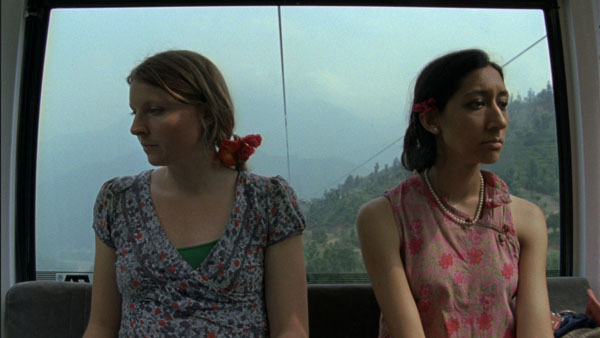“The camera-wielding researchers at Harvard’s Sensory Ethnography Lab, an eccentric team responsible for experimental documentaries like last year’s groundbreaking fishing-boat portrait Leviathan and the shepherd-focused Sweetgrass, typically refuse to identify as ‘filmmakers’ in the traditional sense of the word,” begins Indiewire‘s Eric Kohn. “The group’s latest effort, the startlingly unique viewing experience Manakamana, provides the best case for that claim. Shot with a static camera exclusively within the confines of a cable car as it travels up and down the Nepal Valley for a series of 10-minute rides, Manakamana contains nothing traditionally movie-like in its progression. And that’s exactly what makes it one of the most engrossing cinematic achievements to come along since… well, Leviathan.”
In her report from Locarno here in Keyframe, Kiva Reardon notes that Stephanie Spray and Pacho Velez‘s Manakamana‘s not only a personal favorite from this year’s festival but also that it’s won the top prize from the Concorso Cineasti de presente jury (and it’ll screen in the Toronto‘s Wavelengths program): “Tryingly slow and with no dialogue for the first forty-odd minutes, many in the audience began to stream out during the screening I was at—their loss.”
For Dennis Lim, writing in the Los Angeles Times, Manakamana is “thrillingly mysterious in its effects: a work of staged documentary, a cross between science fiction and ethnography, an airborne version of an Andy Warhol screen test. As with the best structural films, Manakamana is also a kind of head movie, one the viewer is invited to complete. Working within a 5- by 5-foot box, Spray and Velez have made an endlessly suggestive film, one that both describes and transcends the bounds of time and space.”
Adam Cook in the Notebook: “Functioning best at their least intellectual, the Sensory Ethnography Lab films search for new aesthetic experiences in strange, calculated parameters, offering not what Werner Herzog would refer to as an ‘accountant’s truth’ but instead senses and resonances equally if not more valid than the sort of bare anthropological readings such subjects could yield. The one composition of Manakamana is gorgeous. It’s static but always shifting, framing a perpetually evolving landscape, contrasted with various native people, tourists, and, um, goats, that offset the space and the color. As usual with the most successful of the Ethnography Lab films, there’s as much about cinema here as there is anything scientific or academic.”
Update, 8/25: Writing for FIPRESCI, Esther Buss notes that “whereas Leviathan was pure immersion and sensuality, Manakamana negotiates an inward experience as well as a look from the outside. In fact, you feel the swinging of the car, the vibration when it passes the hydraulics of the cable car supports—you even believe you sense a slightly dizziness and a vague pressure on one’s ear while rapidly gaining altitude.”
Update, 9/2: “By eliding the physical (and historical) toll of a once arduous journey, the cable car condenses ritual, and the faith commensurate to it,” notes Jay Kuehner, writing for Cinema Scope. “The question, posed of most new technology, is: Are we thereby delivered to our desired destination (whether sacred or secular) simply more conveniently, or does the very nature of our conveyance alter the nature of our pilgrimage? The Manakamana cable car short-circuits the distance between what Rebecca Solnit poetically describes as ‘mount obscurity and mount arrival.’ Manakamana is a record of this circuitry, an index of faces seen in the act of seeing, thrust into the vacancy of a nature that scrolls by like some uncanny rear projection from an old Hollywood film.”
Update, 9/7: “The necessary repetitiveness of the trips back and forth themselves have a tendency to make even the smallest shifts in expectation seem somehow shocking,” writes Calum Marsh at Film.com, “even maybe revelatory—there’s something about the finality of the journey, following its straightforward cable and heading inevitably to the bottom or top, that makes the details specific to each trip more engrossing. It’s thus that each passenger becomes, in a way, a kind of temporary friend…. The film’s capacity to charm and move seems somehow beyond its means.”
Updates, 9/8: A.A. Dowd at the AV Club: “Here and there, Manakamana settles on a disarming moment: a married couple plainly unable to disguise its discontent, a lovely musical interlude, even a zoological punchline. But the film overstays its welcome; one too many times does that cable car begin its ascent or descent, to the point where the last few fades to black start to feel likes teases.”
Cinema Guild has acquired U.S. rights, reports Matthew Richie in Screen Daily.
Update, 9/11: “Manakamana is a considerable technical and conceptual achievement, but the most surprising thing about it is the way it adds up to a humanist achievement as well,” writes Kenji Fujishima at In Review Online.
Update, 9/19: Manakamana “is a spellbinding work of humanist cinema, and a rigorous experimental documentary that allows its viewers to breathe inside a unique landscape resting somewhere between nature and technology,” writes Peter Labuza at the Film Stage. “If Leviathan did everything in its power to bring us light years from a human experience of the world, Manakamana is our species at its most intimate.”
2013 Indexes: Locarno 2013 Index and Toronto. For news and tips throughout the day every day, follow @KeyframeDaily on Twitter and/or the RSS feed. Get Keyframe Daily in your inbox by signing in at fandor.com/daily.




